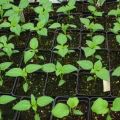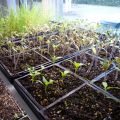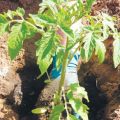When to plant eggplants for seedlings, timing and home care
Eggplant is a heat-loving vegetable from the Solanaceae genus. However, despite this, it is successfully cultivated by farmers and summer residents not only in the southern regions, but also in the middle zone, and even in Siberia. The main thing in the successful cultivation of blue ones is to observe the timing of planting seedlings. When and how to properly plant eggplants for seedlings depends on the region and its climatic characteristics.
Sowing dates for eggplant seedlings
The specific time for sowing blue seeds directly depends on the characteristics of the climate of each region. If the grower does this early, the seedlings will outgrow, stretch out, and will not adapt to the beds after planting. Delayed work will lead to the fact that the vegetables will not be able to mature; they will not have enough sunlight and warm days for their full development.
In the suburbs, middle lane
The first warm days in the Moscow region come only at the end of March, it is in the 20th of this month that the sowing of seeds begins. They do this either in greenhouses, where a heating system is equipped, or in an apartment, growing seedlings on the southern windowsills.
The deadline when it is permissible to carry out work is until April 10, otherwise the sprouts will not have time to form before the time of transplanting to the beds.
For the middle lane, there are two options for carrying out work:
- If the blue ones are planned to be grown in the future in open beds without using a shelter, work is carried out from the middle to the end of the first month of spring, in the first days of June, the blue ones are transferred to the prepared beds.
- If vegetables are planned to be grown in insulated rooms, the seeds are sown in February 15-20, and not later than May 20, the seedlings are transferred to a permanent place.

In Siberia
Usually in Siberia, eggplants are grown in closed heated premises, since the harsh climate makes its own adjustments to the vegetation of plants. But there are daredevils who do it in the open field, collecting decent crops. In order for the cultivation of heat-loving vegetables to be successful, the recommended terms for sowing seeds are adhered to.
Take into account before planting that it takes at least 90 days to get high-quality seedlings. The blue ones are transferred to greenhouses in mid-May, and to the beds - when the air temperature is at least 20 degrees, this is approximately mid-June.
In the Urals
Since the Ural region belongs to areas with risky farming and short summer, it is important to correctly calculate the timing of sowing seeds to obtain seedlings. In addition, the blue ones are cultivated here only in heated premises, otherwise the vegetables will not have time to ripen before the first cold days.

Sowing of blue seeds is carried out in the last days of February. It is not recommended to be late with work, since this representative of the Solanaceae family has a long vegetative period, and the vegetables will not have time to ripen. At the end of May, the seedlings are moved to greenhouses.
In the Leningrad region
The Leningrad Region in terms of climate features is similar to such regions as the Urals and Siberia, therefore summer residents have the opportunity to grow eggplants here mainly in insulated structures. Seedlings begin to grow from the first days of May, so that as soon as the threat of nighttime drops in temperature passes, it is ready for transplantation to a permanent place. This procedure is carried out at the beginning of the first summer month.
Lunar calendar
Often, gardeners, growing blue ones, take into account the recommendations of the lunar calendar, which indicates favorable and unfavorable days for sowing seeds. If you do this on bad days, the eggplant will not grow well and the sprouts will be weak.
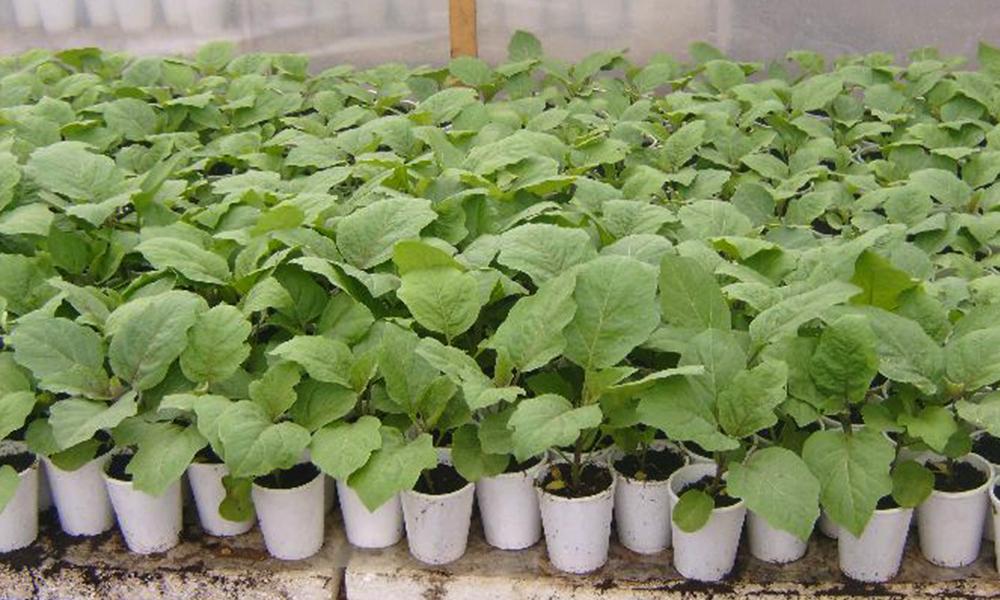
In February:
- Auspicious days: 1, 2, 3, 6, 7, 14, 15, 25, 28, 29.
- Inappropriate numbers: 9, 22, 23, 24.
For March, the recommendations are:
- Sowing is recommended 1, 4, 5, 6, 13, 14, 22, 27, 28.
- It is not worth doing work on 9, 23, 24, 25.
In the southern regions, gardeners have the opportunity to grow seedlings in April due to climatic features. For them, the recommendations are as follows:
- Suitable days: 1, 2, 9, 10, 18, 19, 28, 29.
- Unfavorable dates: 8, 22, 23, 24.
Basic rules for growing
In order for the seedlings to grow healthy and strong, and in the future many fruits set on the bushes, it is necessary to adhere to the recommendations of experienced gardeners for sowing seeds and further agrotechnical care of the sprouts. A soil with a balanced composition is selected, seeds are sown on time and blue seedlings are provided with the necessary conditions for full development.
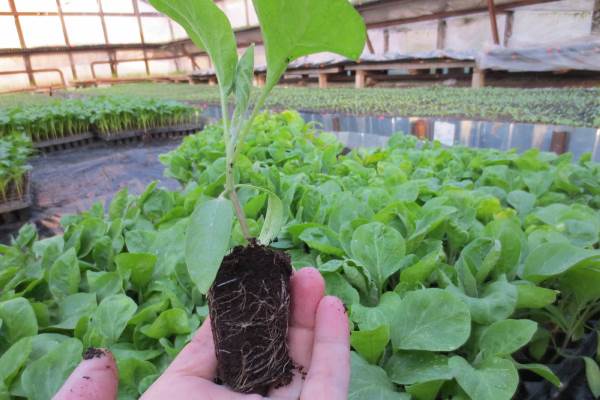
Soil selection
It is recommended to prepare the soil for sowing seeds yourself, then there will be confidence in its quality and nutritional value. The components are mixed in the following proportions:
- humus (8 parts);
- potassium salt (1 part);
- mullein (1 part);
- sod land (2 parts);
- superphosphate (1 part).
To increase the nutritional value of the soil, a teaspoon of urea and half a glass of wood ash are also added to it, if necessary. There are several other recipes for creating a potting soil mixture for sowing eggplant seeds. In the first case, it is recommended to mix 1 part of sod land with 2 parts of humus and add 0.5 parts of sawdust and 1 part of non-acidic peat to them. In the second recipe, 1 part of sawdust and 3 parts of peat are prepared, which are watered before planting with any composition for the speedy germination of seedlings.

Regular soil from the garden is also suitable for growing eggplant seedlings, preferably the one that grew cucumbers or cabbage last year.
Preparation of planting material
The main requirement for obtaining high-quality, strong and healthy seedlings is the correct choice of seed material. They buy seeds from trusted producers in gardening stores. Material purchased from hands will not guarantee 100 percent germination.
Before sowing, the seeds are prepared, they do it in compliance with the step-by-step instructions, which include 4 stages:
- Warming up the material. This can be done in two ways: dry and hydrothermal. In the first case, the oven is heated to 55 degrees and the seeds are kept in it for 2-4 hours. Or laid out on a towel on a battery and heat the material for 2.5-3 months.The second method involves soaking the seeds in a jar of water (temperature - about 45-50 degrees). The container is covered with a lid and the material is kept for 5 minutes. Such seeds show increased germination and immunity to diseases.
- Seed dressing. To do this, take a 10% solution of hydrogen peroxide and dip the material into it for 15-20 minutes. Instead of peroxide, you can take a non-concentrated solution of potassium permanganate.
- Material hardening. Take two cuts of damp cotton cloth and place seeds between them. They are kept there for at least 20 hours (temperature is within 20-22 degrees). After they put the seeds in the refrigerator for 8 hours, then they are again kept for 20 hours at room conditions. This procedure is carried out for 7-8 days.
- Soak. 2-3 days before the intended planting, the seeds are soaked in water (preferably rain or thawed). It should be noted that the liquid should not completely cover the seed. After the seeds are dried, they begin planting work.
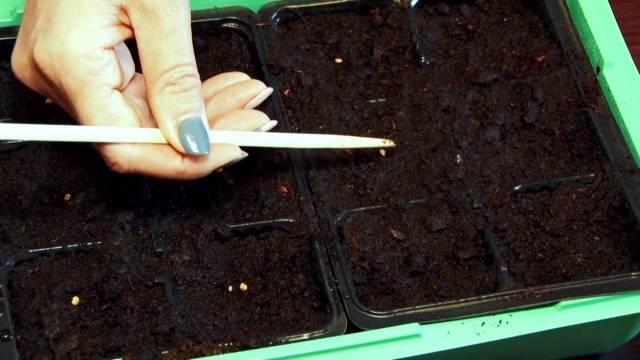
Choice of capacity
For growing seedlings, the following containers are taken: plastic and peat pots, cut bottles, cups left over from yogurt or sour cream. The main requirement is sufficient height and availability of drainage holes.
Sowing process
When planting seeds, observe the instructions, then the sprouts will quickly appear from the ground, and the germination of seeds will be at a high level.
The master class looks like this:
- Soil is poured into prepared containers by 2/3.
- Irrigate and wait for the moisture to be completely absorbed.
- The seeds are buried 2-3 cm.
- A small layer of earth (1 cm) is poured on top.
- Slightly compact and watered again.
- Cover with plastic wrap or glass and place in a warm place out of the sun until germination.
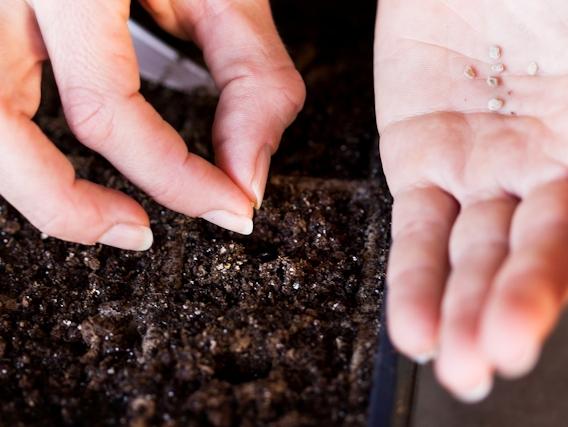
It is recommended to sow blue seeds in the morning.
Seedling Care Tips
After the sprouts have appeared, it is important to provide them with proper care.
Lighting
After the seedlings have risen, they provide it with full lighting, which should last at least 10 hours a day. However, young sprouts must be shaded from the hot midday sun so that they do not burn out. If the weather is cloudy, install fluorescent lamps for additional lighting. Every 2 days, turn the seedling pots with the other side to the light so that they develop evenly.
Temperature
After the film is removed from the sprouted sprouts, the temperature is reduced to 16 degrees. After a week, they are raised to 20-22 degrees. At night it can be reduced to 14 degrees, this difference helps to strengthen the immunity of plants.
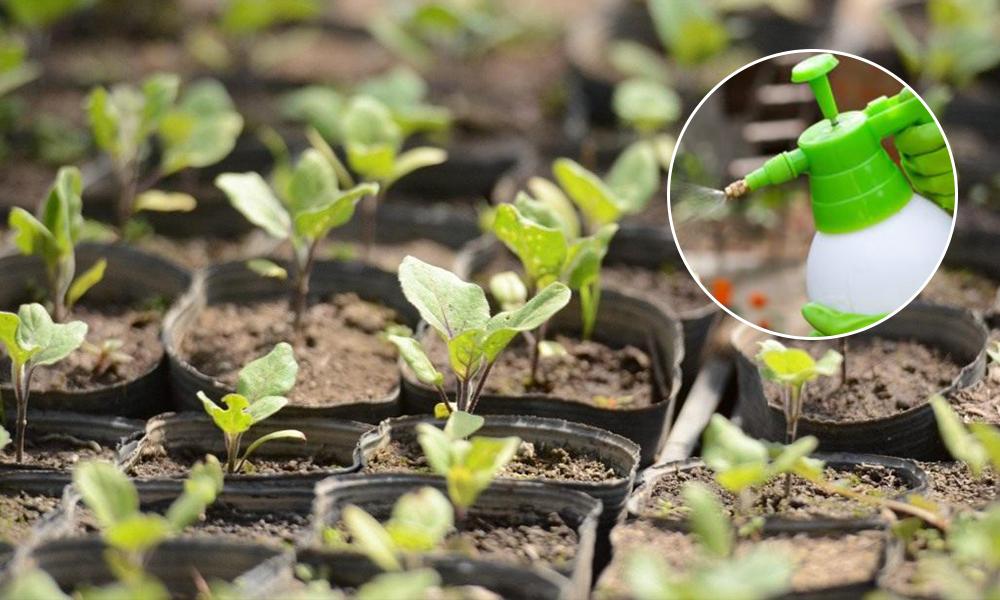
Watering and feeding
Moisten the sprouts moderately so as not to cause decay of the roots and an outbreak of fungal pathologies. Pour water gently under the root using a fine-mesh watering can. It is only necessary to feed the seedlings if the sprouts look weak and thin. A mixture of superphosphate and potassium sulfate in equal proportions is well suited for this. But it must be remembered that the excessive introduction of nutrients negatively affects young shoots.
Living space
If at home blue ones are grown in separate cups, a pick is not required. If not, then put the eggplants in separate cups and immediately spill the soil with Kornevin so that they take root better. Many gardeners practice planting 2-3 seeds in one pot, after they have sprung up, they leave the strongest one, the rest are removed.

Prevention of diseases and pests
The best measures for the prevention of diseases and pests is considered to be competent care of seedlings. The watering regime is observed, since excessive moisture causes outbreaks of fungal diseases. Also, as a preventive procedure, the sprouts are sprayed with Fitosporin solution.
Possible problems
To grow full-fledged seedlings and avoid any problems, you must strictly follow the recommendations of experienced gardeners. An insufficient amount of sunlight falling on the seedlings throughout the day, and non-adherence to the feeding schedule leads to the fact that the blue ones stretch out, and the low temperature in the room slows down growth.
When and how to plant seedlings in a greenhouse or open ground
You should not allow the overgrowth of seedlings, otherwise it will be quite difficult for the blue to adapt and take root in the beds. It is preferable to plant the shoots in the same soil composition that was used for sowing seeds. It is not recommended to plant vegetables in places where other members of the Solanaceae family were previously grown. Legumes, carrots, or cabbage are considered ideal precursors for eggplant.





